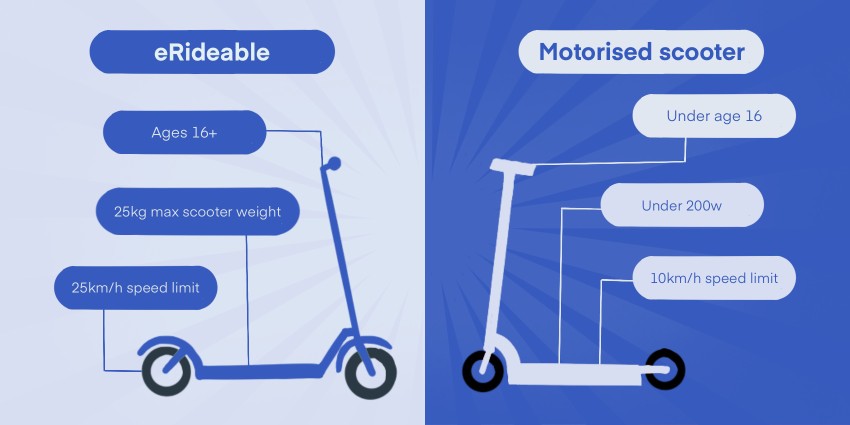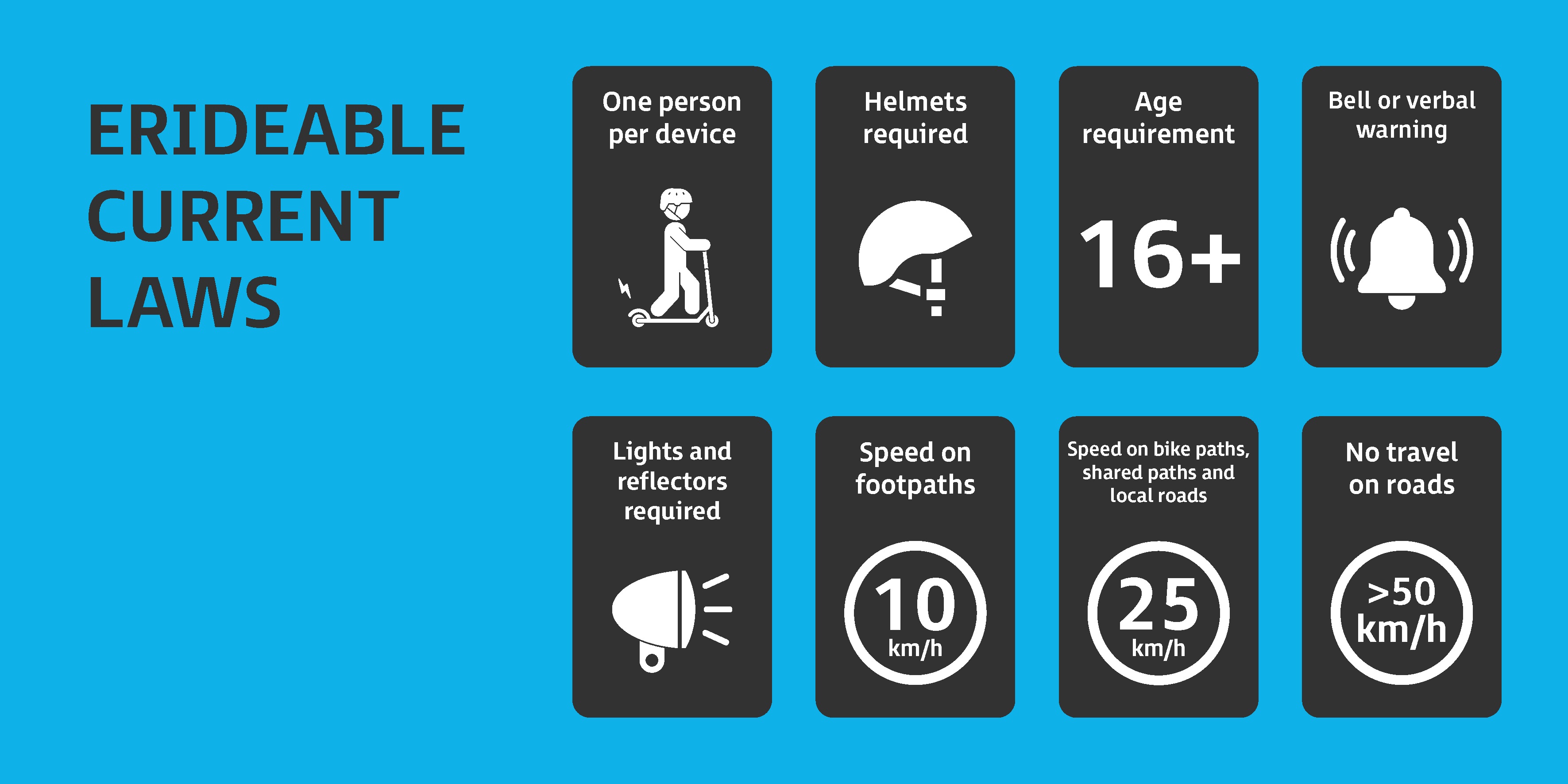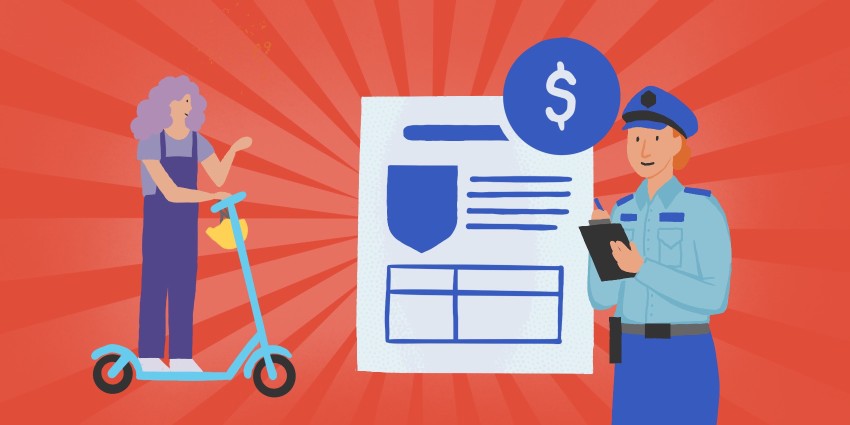Only people aged sixteen and over are allowed to use eRideables.
An eRideable is an electric rideable device that:
- has at least one wheel
- is designed for one person
- doesn't go faster than 25km/h on level ground
- weighs 25kg or less
- is no more than 125cm long, 70cm wide and 135cm high.
Examples include eScooters, eSkateboards, hoverboards, eSkates, and eUnicycles.
Other devices such as mobility scooters, motorised wheelchairs, or low-powered motorised scooters for children are not considered eRideables and are covered by their own rules. For more detail on the difference between eRideables, motorised scooters, and other similar devices, see 'eRideable definitions and buying guide' at the bottom of this page.
eRideables rules and safety
eRideables are a type of vehicle, so all road laws that apply to vehicles apply to eRideables as well unless expressly excluded. Read on to find out what rules are specific to eRideables and how you can ride safely.
- Keep to the speed limit. On footpaths and pedestrian crossings, this is 10km/h. On and bicycle paths, shared paths and local roads eRideables can be ridden up to 25km/h where safe.
- One person per device. Never carry passengers or animals on your eRideable.
- Wear a helmet. Any approved bicycle, skateboard or motorcycle helmet can be worn when riding an eRideable.
- Hands on the wheel, not on your phone. Always have at least one hand on the handlebars (if fitted). Don’t be distracted by your mobile phone – the same rules apply to eRideables as to bikes, motorcycles and cars.
- Don’t drink and ride. eRiders must maintain proper control of their eRideable device at all times and are subject to the same drink and drug driving laws as car drivers.
- Put your eRideable somewhere safe. Never leave your eRideable on the road or path - it could get in the way of other users.
Sharing the road safely
- Be visible. Use lights and reflectors when riding at night.
- Give way to pedestrians and keep left unless overtaking.
- Use a bell or verbal warning before approaching or overtaking pedestrians or other path users. A bell or other warning device must be fitted to the eRideable, but if fitting a bell onto the device isn't possible - say if your device is an eSkateboard - then call out to pedestrians and other path users to let them know you are there.
- Use hand signals to indicate your plans to other road users when turning.
- Ride single file when riding with a group.
- Give cars plenty of space. If you’re riding on a local road, make sure there’s at least 2 metres between you and the back of any motor vehicle. Never attach yourself to, or allow yourself to be pulled along by, any other vehicle.
- Ride to the conditions. Slow down when passing pedestrians, before turning corners, or where there is congestion.
Speed limits for eRideables
| Location | Speed Limit |
|---|---|
| Footpaths | 10 km/h |
| Bicycle paths and shared paths | 25 km/h |
| Local roads and bicycle lanes | 25 km/h |
| Pedestrian crossings | 10 km/h |
A note on pedestrian crossings
eRiders and cyclists no longer need to dismount at pedestrian crossings and can simply ride across. This rule applies when the rider enters the crossing from the connected path and not the road. Riders must not exceed 10km/h and must give way to pedestrians.
Where to ride your eRideable
- footpaths, bicycle paths and shared paths
- roads where there are no dividing lines AND the speed limit is 50 km/h or less
- bicycle lanes (on roads with a speed limit of 50km/h or less).
It is illegal to ride on:
- roads with a dividing line
- roads where the speed limit is more than 50km/h
- any path marked ‘no wheeled devices’
- any path or road where a ‘no bicycle’ sign or marking applies.
When using a separated path, eRideables should use the bicycle part. It is illegal to ride in the section marked for pedestrians.
Mobile phones and eRideables
eRiders may not hold a mobile phone in their hand while riding. If the phone is secured in a mounting affixed to the eRideable, the rider may:
- touch it to make or receive an audio call
- make or receive an audio call without touching it
- use it as a driver’s aid (e.g. navigation, vehicle monitoring including speed monitoring) without touching it.
If the phone is attached to the rider’s arm (not hand), the rider may:
- make or receive an audio call without touching it
- use it as a driver’s aid (e.g. navigation, vehicle monitoring including speed monitoring) without touching it.
If the phone is not secured to the riders arm or in a mounting affixed to the vehicle, the rider may still use it to make or receive a call, provided they do not touch it to do so.
For more information, visit our Mobile phones and distractions page.
Explore the links below to find out more about what devices are considered eRideables, and information on offences and penalties.

eRideable definitions and buying guide
eRideable learning resources
Show moreFor printable posters, fact sheets and learning materials, visit our eRideable resources page.
eRideables Fact Sheets and Posters
Our Get Streetwise website has videos and quizzes on eRideables and other road safety topics.
Take the eRideables Get Streetwise Quiz
eRideable media campaigns
Show moreTo find out more about the eRideable campaigns, or to access campaign material such as videos, flyers, or social media content, explore the links below.
To see all our Campaigns, please visit the Campaigns page.
Other useful links
Show moreWA Legislation - Road Traffic Code 2000 (eRideables are referred to as electric rideable devices in the Road Traffic Code 2000)
Australian Road Rules - the Australian Road Rules are model laws which form the basis of road rules of each Australian state and territory.
Active Transport - view the bike and shared path networks in metropolitan Perth and around the state.
Public Transport Authority - for information on carrying your device on public transport in WA.
Consumer Protection (Department of Mines, Industry Regulation and Safety) - what you should know before purchasing an eRideable device.




